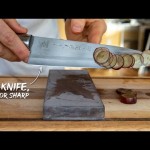
6d7f6c5ddf67710ee9db733bb75eb2bb
Having a sharp knife is essential for any kitchen. Whether you are a professional chef or a home cook, having a sharp knife can make all the difference in your cooking. Carbon steel knives are known for their sharpness and durability, but they require regular sharpening to maintain their edge. In this article, we will provide a step-by-step guide on how to sharpen a carbon steel knife. We will cover the tools and techniques you need to know to keep your knife sharp and ready for use.
What is the step be step process of sharpening your knife on a sharpening steel
Sharpening your knife on a sharpening steel is a great way to keep your knife in top condition. It is important to use the correct technique when sharpening your knife on a sharpening steel, as this will ensure that your knife is sharpened correctly and safely. Here is a step-by-step guide to help you sharpen your knife on a sharpening steel.
Step 1: Prepare the Knife and Steel
Before you begin sharpening your knife, you need to make sure that both the knife and the sharpening steel are clean and free of any debris. You should also check that the sharpening steel is in good condition and that the blade is not damaged.
Step 2: Position the Knife
Once you have prepared the knife and the sharpening steel, you need to position the knife correctly. Hold the sharpening steel in your dominant hand and the knife in your other hand. Place the blade of the knife against the steel at a 20-degree angle. Make sure that the blade is in contact with the steel at all times.
Step 3: Sharpen the Knife
Once the knife is in the correct position, you can begin to sharpen the knife. Start at the base of the blade and draw the knife down the steel in a smooth, sweeping motion. Make sure that you keep the blade in contact with the steel at all times. Repeat this motion several times, making sure to sharpen both sides of the blade.
Step 4: Check the Sharpness
Once you have finished sharpening the knife, you should check the sharpness of the blade. To do this, you can use a piece of paper or a tomato. If the blade is sharp, it should easily cut through the paper or tomato. If the blade is not sharp, you may need to repeat the sharpening process.
Step 5: Clean and Store the Knife
Once you have finished sharpening the knife, you should clean the blade and the sharpening steel. Use a damp cloth to wipe away any debris from the blade and the steel. Once the knife and steel are clean, you should store the knife in a safe place.
Sharpening your knife on a sharpening steel is a great way to keep your knife in top condition. By following the steps outlined above, you can ensure that your knife is sharpened correctly and safely.
Can carbon steel knives be sharpened
Carbon steel knives are known for their sharpness and durability, but they can become dull over time. The good news is that carbon steel knives can be sharpened, and it is relatively easy to do.
Sharpening a carbon steel knife requires a sharpening stone, which is a flat stone with a rough surface. The stone is used to grind away the dulled metal on the blade, creating a sharp edge. It is important to use the correct type of stone for the type of steel used in the knife, as some stones are too hard for certain types of steel.
When sharpening a carbon steel knife, it is important to use the correct technique. The blade should be held at a 20-degree angle to the stone, and the stone should be moved in a circular motion. This will ensure that the blade is sharpened evenly and that the edge is not damaged. It is also important to use light pressure when sharpening, as too much pressure can damage the blade.
Once the blade has been sharpened, it is important to maintain the sharpness of the blade. This can be done by honing the blade with a honing steel. This is a rod-shaped steel that is used to realign the edge of the blade. It is important to use the correct honing steel for the type of steel used in the knife, as some steels are too hard for certain types of honing steels.
Sharpening a carbon steel knife is not difficult, but it does require some skill and knowledge. It is important to use the correct sharpening stone and honing steel for the type of steel used in the knife, and to use the correct technique when sharpening.
With the right tools and technique, a carbon steel knife can be kept sharp and ready for use.
What are the proper steps used in sharpening a knife
Sharpening a knife is an important skill to have, as it can help you keep your knives in top condition. It is important to know the proper steps to take when sharpening a knife, as it can help you get the best results. Here are the steps you should take when sharpening a knife:
Step 1: Choose the Right Sharpening Tool
The first step in sharpening a knife is to choose the right sharpening tool. There are a variety of sharpening tools available, such as whetstones, electric sharpeners, and honing steels. Each of these tools has its own advantages and disadvantages, so it is important to choose the one that best suits your needs.
Step 2: Prepare the Knife
Once you have chosen the right sharpening tool, the next step is to prepare the knife. This involves cleaning the blade and removing any dirt or debris that may be on it. It is also important to make sure that the blade is dry before you begin sharpening.
Step 3: Sharpen the Knife
The next step is to sharpen the knife. Depending on the type of sharpening tool you are using, the process may vary. For example, if you are using a whetstone, you will need to move the blade in a circular motion against the stone. If you are using an electric sharpener, you will need to follow the instructions provided with the device.
Step 4: Test the Sharpness
Once you have finished sharpening the knife, it is important to test the sharpness. This can be done by cutting a piece of paper or a tomato. If the knife is sharp enough, it should easily cut through the paper or tomato.
Step 5: Clean and Store the Knife
The final step is to clean and store the knife. This involves wiping the blade with a clean cloth and then storing it in a safe place. It is important to make sure that the blade is completely dry before storing it, as moisture can cause the blade to rust.
Sharpening a knife is an important skill to have, and following the proper steps can help you get the best results. By choosing the right sharpening tool, preparing the knife, sharpening the blade, testing the sharpness, and cleaning and storing the knife, you can ensure that your knives stay in top condition.
What is the best angle for a carbon steel knife
Carbon steel knives are a popular choice for many chefs and home cooks due to their durability and sharpness. However, the angle of the blade is an important factor to consider when choosing a carbon steel knife. The angle of the blade affects the sharpness and performance of the knife, so it is important to choose the right angle for your needs.
Edge Angle
The edge angle of a knife is the angle between the blade and the cutting edge. A sharper angle will provide a sharper edge, but it will also be more prone to chipping and dulling. A duller angle will provide a less sharp edge, but it will be more durable and less prone to chipping. Generally, a blade angle of 15-20 degrees is considered to be the best for a carbon steel knife.
Bevel Angle
The bevel angle of a knife is the angle between the blade and the back of the blade. A steeper angle will provide a sharper edge, but it will also be more prone to chipping and dulling. A shallower angle will provide a less sharp edge, but it will be more durable and less prone to chipping. Generally, a bevel angle of 20-30 degrees is considered to be the best for a carbon steel knife.
Overall Angle
The overall angle of a knife is the combination of the edge angle and the bevel angle. A sharper overall angle will provide a sharper edge, but it will also be more prone to chipping and dulling. A duller overall angle will provide a less sharp edge, but it will be more durable and less prone to chipping. Generally, an overall angle of 35-45 degrees is considered to be the best for a carbon steel knife.
Choosing the right angle for your carbon steel knife is an important factor to consider when selecting a knife. The angle of the blade affects the sharpness and performance of the knife, so it is important to choose the right angle for your needs. Generally, an overall angle of 35-45 degrees is considered to be the best for a carbon steel knife.
We hope this guide has been helpful in teaching you how to sharpen your carbon steel knife. With the right tools and a bit of practice, you can keep your knife in top condition for years to come. Goodbye and happy sharpening!















